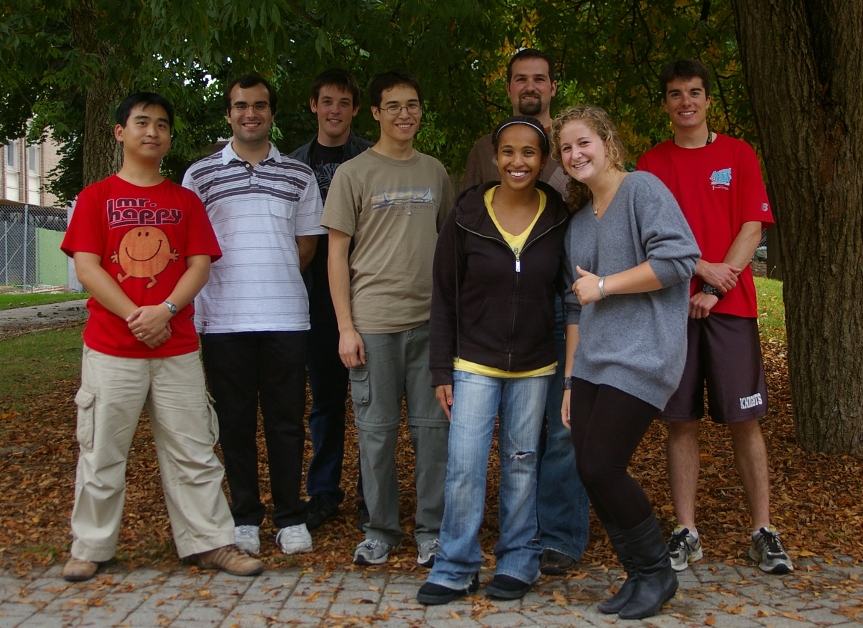Team:Waterloo
From 2009.igem.org
(→Team Waterloo 2009 Project: Chromobricks: A Platform for Chromosome Engineering with BioBricks) |
|||
| (6 intermediate revisions not shown) | |||
| Line 1: | Line 1: | ||
| - | + | {{Team:Waterloo/NavBar}} | |
| + | |||
| + | == '''Team Waterloo 2009 Project:<br> <i>Chromobricks: A Platform for Chromosome Engineering with BioBricks</i> ''' == | ||
| - | |||
The aim of our project is to develop a fully-featured platform for chromosome engineering, allowing the in vivo assembly of a synthetic chromosome from interchangeable parts, followed by selective degradation of the native chromosome. We have designed a proof-of-concept for chromosome-building that will use the site-specific integrase of phage ΦC31 to integrate a BioBrick into a defined locus of the <i>E. coli</i> genome. Six pairs of integrase-targeted <i>att</i> sites have been designed to be non-cross-reactive in order to support repeatable cassette-exchange reactions for chromosome building. We have also written software to model the integrase-mediated rearrangement of DNA molecules containing <i>att</i> sites, to aid the design of more elaborate chromosome-building systems. To selectively degrade the native chromosome we designed a nuclease-based, inducible genome-degradation system. In its simplest form, our system can be used to integrate biological devices into a chromosome in situations requiring stable copy number and selection-free maintenance. | The aim of our project is to develop a fully-featured platform for chromosome engineering, allowing the in vivo assembly of a synthetic chromosome from interchangeable parts, followed by selective degradation of the native chromosome. We have designed a proof-of-concept for chromosome-building that will use the site-specific integrase of phage ΦC31 to integrate a BioBrick into a defined locus of the <i>E. coli</i> genome. Six pairs of integrase-targeted <i>att</i> sites have been designed to be non-cross-reactive in order to support repeatable cassette-exchange reactions for chromosome building. We have also written software to model the integrase-mediated rearrangement of DNA molecules containing <i>att</i> sites, to aid the design of more elaborate chromosome-building systems. To selectively degrade the native chromosome we designed a nuclease-based, inducible genome-degradation system. In its simplest form, our system can be used to integrate biological devices into a chromosome in situations requiring stable copy number and selection-free maintenance. | ||
| - | + | [[Image:UWiGEMF09teampictures800px.JPG|thumb|center|x500px|frame|Those who showed up for picture day]] | |
| - | + | ||
| - | + | ||
| - | + | ||
| - | + | Supported by [[Image:UWiGEMSciFac.png]] | |
| - | + | ||
| - | + | ||
| - | + | ||
| - | + | ||
| - | + | ||
| - | + | ||
| - | + | ||
| - | + | ||
Latest revision as of 21:39, 21 October 2009
Team Waterloo 2009 Project:
Chromobricks: A Platform for Chromosome Engineering with BioBricks
The aim of our project is to develop a fully-featured platform for chromosome engineering, allowing the in vivo assembly of a synthetic chromosome from interchangeable parts, followed by selective degradation of the native chromosome. We have designed a proof-of-concept for chromosome-building that will use the site-specific integrase of phage ΦC31 to integrate a BioBrick into a defined locus of the E. coli genome. Six pairs of integrase-targeted att sites have been designed to be non-cross-reactive in order to support repeatable cassette-exchange reactions for chromosome building. We have also written software to model the integrase-mediated rearrangement of DNA molecules containing att sites, to aid the design of more elaborate chromosome-building systems. To selectively degrade the native chromosome we designed a nuclease-based, inducible genome-degradation system. In its simplest form, our system can be used to integrate biological devices into a chromosome in situations requiring stable copy number and selection-free maintenance.
 "
"

